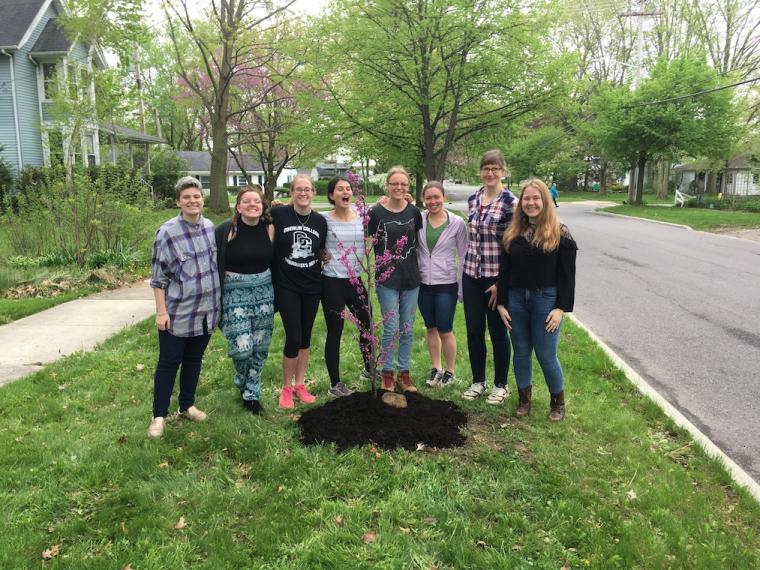First-Year Seminar Creates Learning Community Based on ‘Radium Girls’
May 23, 2018
Amanda Nagy

Seven of the students in Associate Professor Rebecca Whelan's first-year seminar came to plant a redbud tree on Whelan's property in early May. From left: Julia Crewe-Kluge, Caitlin McDermott, Allison Schmitt, Alexis Quirk, Alex Wooldredge, Heidi Scott, Whelan, and Emily Spezia-Shwiff.
Photo credit: Courtesy of Rebecca Whelan
It’s been 120 years since Marie Curie, the most famous woman scientist in history, discovered radium and radioactivity with her physicist husband and collaborator Pierre Curie. Now, consider for a moment, who we think of as our modern-day Marie Curie. And just what, exactly, do we envision when we think of a scientist?
In a first-year seminar taught by Associate Professor of Chemistry and Biochemistry Rebecca Whelan, “Marie Curie’s Legacy: Radium Girls and Glowing Matter,” students investigated complex questions about gender roles in the sciences. Through readings and visits to the Allen Memorial Art Museum and College Archives, the class studied the lives of important historical figures such as Curie and chemist Rosalind Franklin (whose contribution to the discovery of DNA was grossly undermined), learned about the infamous “radium girls” and the effects of radioactivity on the body, and gained insight into the current landscape for women scientists.
For Whelan, it was the first time teaching a first-year seminar under the new Peer Advising Leaders (PAL) program, which brings together cohorts of students to create community and helps them navigate their first year of college. Because most of the class already belonged to the same PAL cohort, there was an immediate rapport. Whelan says half of the students are a on a science track, with the other half pursuing music and humanities.
“I think that gave us an interesting source of different perspectives,” Whelan says. “They also had varying levels of faith or skepticism in the scientific community.”
Whelan decided to let students lead discussions from the beginning of the semester. They were tasked with coming up with their own lesson plans, and they did this each class in pairs.
“One deceptively simple question that always sparked a lively discussion was, ‘Was Marie Curie a feminist?’ We had very intense debates on this topic. Another was innate brilliance versus hard work, as we’ve seen historically that this is a way to keep women in the lower echelons. For example, men are more often perceived as brilliant, while women are seen doing the drudgery or having to work extra hard.”
The class further engaged with these questions during three visits to the museum. The first session analyzed depictions of nurses in WWI and WWII because of Curie's important medical role and impact in WWI. The second visit discussed problematic gendered representations of science in a series of works, and the last visit addressed the ways in which nuclear energy and radiation impact the environment and the human body.
Heidi Scott says the seminar inspired her to continue engaging with her love for science and to pursue a major in either biology or neuroscience.
“This seminar encouraged me to think critically about the impact gender has on how research is conducted, what research is conducted, and who gets to do the research. Numerous times, I considered the scientific process and the extent to which each stage could be impacted by gender,” says Scott, who is from Ontario, Canada.
After the semester ended, the class formed a group chat, affectionately named “Radium Girls,” which they’ve used to stay in touch.
“Through the course, I've experienced what a real learning community is,” says Allison Schmitt, an intended German major from Lancaster, Pennsylvania. “A large part of the class was the emphasis on the ways in which women of color experience the effects of this discrimination, and it was really important that we did not ignore that gender biases in science are not confined to white women.”
“We all became friends and supported each other, even outside of the classroom,” says Emily Spezia-Shwiff, an intended history and musical studies major from Hood River, Oregon. “Because we had so many opportunities to discuss our ideas in class, we got to know each other as people and we created a very supportive and open environment.”
The class met for coffee after winter term, watched a concert together halfway through spring semester, and periodically met for dinner to catch up. This spring, a majority of the students met to plant a tree on Whelan’s property. The idea for planting a tree was inspired by the class reading of Lab Girl, a 2016 memoir by geobiologist Hope Jahren that tells her coming-of-age story and the obstacles she’s faced as a woman scientist. A recurring thread in the book is the staggering rate of deforestation around the world.
“The reader can tell that Hope Jahren really loves trees,” Whelan says, “and she implores everyone to go out and plant one.”
Whelan chose a redbud tree—one of her favorites, and prevalent around Oberlin—for its tiny dark pink flowers. The class named the tree Rosalind Marie in honor of the scientists they studied.
“I feel that it was important to be teaching this class,” Whelan says. “I identify as a woman, as a feminist, and as a scientist, and I am a role model. I hope that as these students continue with their time at Oberlin, they can walk by South Professor Street and watch the tree grow.”
You may also like…
Josh Nolan Named Vice President, General Counsel, and Secretary at Oberlin
Distinguished attorney brings extensive experience in higher education law.
Learning by Teaching: Oberlin Students Share Global Music with Young Learners
College and Conservatory students in PACE 103 prepare local children for an immersive community concert at Oberlin.
Nuiko Wadden ’02 Joins Oberlin Conservatory Faculty as Assistant Professor of Harp
The versatile musician brings extensive opera, orchestral, and contemporary music experience to her role


